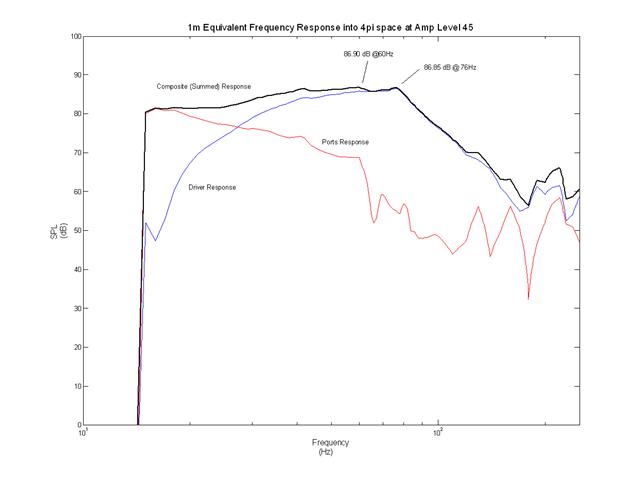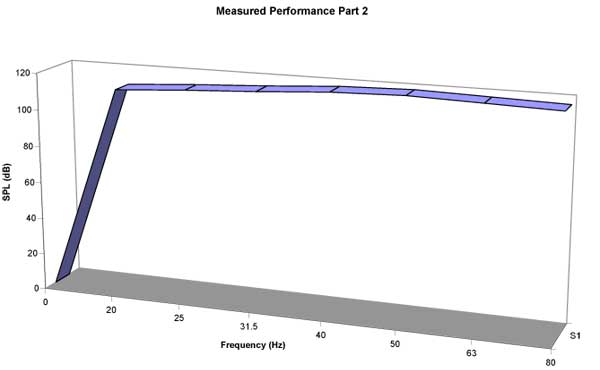Foreshadowing - Predicted and Measured Results
To cut to the chase, and before you decide to read
on, your probably wondering how the finished product worked out. Well in my
unbiased (ha!) opinion, pretty darn well! The simulations predicted a nearly
flat response (within 3 dB) through a range of 15 Hz - 150 Hz. The sound was
predicted to be "tight and accurate" based on the group delay in the
simulations, and it varied in a gentle slope from 0-8ms (150 Hz - 28 Hz) throughout
the frequency range with a rapidly increasing delay below 28 Hz.
For the measured results, I tested the sub a number of times. Initially, I
again turned to Ron. He showed up one night with a calibrated microphone and
a laptop one night and we ran frequency sweeps from 20 Hz to 80 Hz, testing every
frequency point within the range. He placed the microphone nearly touching
the drivers and next to one of the ports to eliminate the effect of the room
in the measurements. Data in hand, he extrapolated the results to 1 meter in
4π space. I'm told this predicts what the speakers' performance would be
"in
the middle of nothing". One of the resulting graphs (reflecting a
conservative volume that evidenced no clipping) can be seen in the graph
below.

In the graph, the extrapolated driver response curve is shown in blue. The
summed port response taken from data of a single port (6 dB added to estimate
the response of the second port) is shown in red (also extrapolated into 4π
space). The black, composite response line assumes that driver and port will
add in phase throughout the spectrum and thus reflects the best case overall
frequency plot. The results were close to the predicted values 95
± 3 dB in
the target frequency band.
I must admit that after this first round of tests, I was disappointed with
the measured results. Why didn't I see the 115 dB performance of some of the
benchmarks subs? I suspected a few things. First, the sub was new when
measured and not entirely broken in. Mechanically, speakers tend to loosen
up with use, and performance can improve. Second, the data collected were
extrapolated to the 4π space. This mathematical approach does isolate the
actual response of the speaker but does not necessarily reflect in room
performance. Finally, we weren't really pushing the sub all that hard for
these frequency sweeping tests. Just playing around, I was seeing 120 dB peaks
using the same microphone placement.
To address some of my concerns with the first measurements, I went back and
re-measured the sub's performance. There were two major differences in this
test. First, I allowed the sub hundreds of hours of time to break in.
Second, I took a more "Average Joe" approach do doing the measurements. As
in the previous test, I measured the sub as close as possible to the driver to
reduce the effect of the room. However, this time I ignored the ports and
used a standard Radio Shack SPL Meter (model # 33-2050) and the Mobile Fidelity
Sound Check test disk. The Results of the test are in the table below. Note
that the accuracy of this SPL meter is not the greatest, so I applied the
corrections published elsewhere on this site (http://www.hometheaterhifi.com/utilities-download-page.html)
to my actual measurements.

As before, the sub's measured performance was flat as predicted by the BassBox simulations. The measured results are flat in the frequency range of
the sub (between 20 Hz and 80 Hz), and the level peaks at 120 dB at 50 Hz. Am I
happy now? Heck Yeah! The sub measures as well as predicted and sounds great
to boot.
Click Here to Go to Part III.